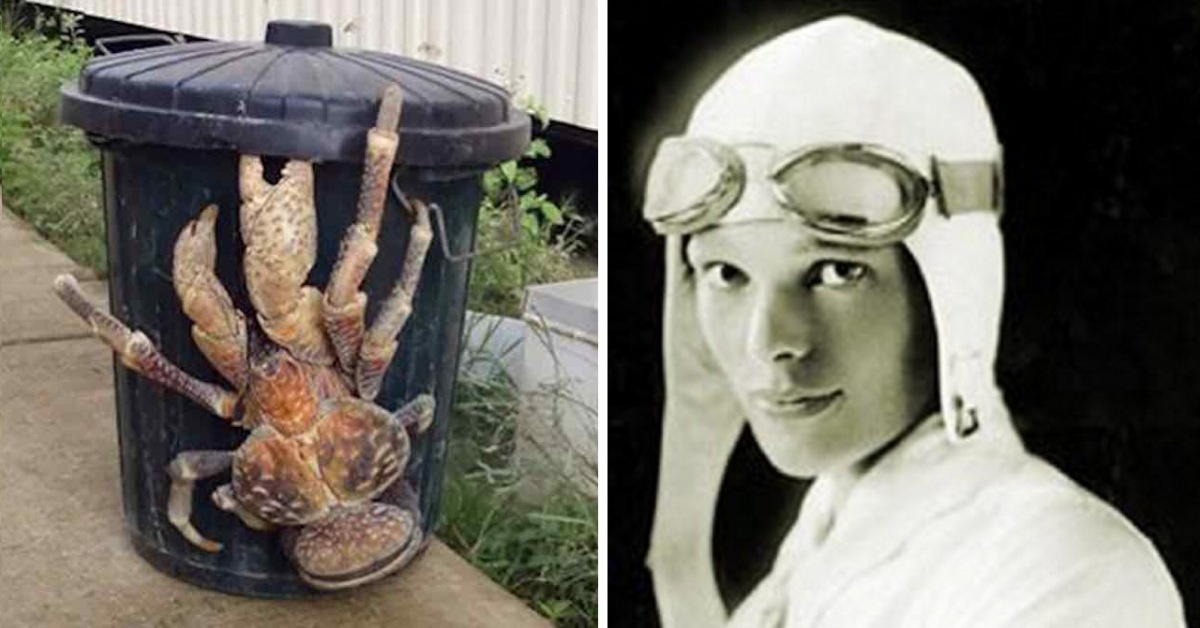The coconut crab – the world’s largest land crab – can weigh over 4 kg (8.8 lbs) and span nearly a meter (3 feet) across. This guy can rip open a coconut with its power-claws, plus it can also climb trees (ouch)! And, it could be the animal that devoured aviation pioneer Amelia Earhart…
“Monstrous.”
This was the word that left Charles Darwin’s lips when he first saw a coconut crab. And indeed, it’s no ordinary crab. It’s strong enough to carry more than six times its own weight.
In Darwin’s days, there were rumors that the crabs could climb trees and dangle from them for hours, holding on by nothing more than a single pincer – like some massive overgrown spider. There were stories that their claws were so strong that they could break through a coconut. And some claimed they could tear a human being apart, limb by limb.
Darwin didn’t believe most of these rumors, but in the end they turned out to be no exaggeration. Since then, every story about this horrifying-looking creature has proved to be true.

Take their pincers, for example. They are some of the most powerful and most dangerous weapons in the entire animal kingdom. If you’re unlucky enough to have one of them clamp down on your leg, its grip will have as much power as a bite from a lion’s jaws.
Yes, you’ve read that right. It’s no coincidence that the people in this picture don’t move. At all.

Thanks god, they hardly use those terrifying claws on humans as their main source of food is, as their name suggests, coconuts. And they have no problems tearing a coconut apart with nothing more than their bare claws, which is kind of alarming…
But, these crabs aren’t too picky with their diet – they’ll eat just about anything. They’ve been observed hunting and killing birds, tearing apart live pigs, and even cannibalizing the corpses of the fellow members of their species.
And, they’ll even eat their own dried-up shell when it’s time for it to fall off and give way to a new one. They eat it whole, chewing up slowly. Yikes…

Tearing a coconut apart doesn’t happen very quickly though. The process can actually take several days before the coconut is opened by the crab. And that’s where another interesting ability of these animals comes into the picture.
These gigantic crabs are excellent climbers – they can basically climb anything they see. They can take a coconut from the ground, cut the husk and grab it with their claw, climb up a tree 10 m (33 ft) high and drop the nut to access the flesh inside quickly.
Even more surprisingly, they often descend from the trees by falling, and can survive a fall of at least 4.5 m (15 ft) unhurt!

Please help keep this site AD AND PAYWALL FREE! Donate to keep Earthly Mission going!
 Donate
DonateThe pincers of these crabs are so strong that they can hang off anything they can get a hold of for hours, be it the branches of a tree, the chains in a fence, or the walls around a home.
They don’t just climb trees to get fruit, though. In some places, they mostly prey on birds, by climbing to the tops of trees to attack them and drag them down to the underground burrows where they live.
Here’s a video demonstrating their incredible climbing abilities.
As already pointed out, coconut crabs don’t usually try to hurt people, but there can be exceptions. Humans are their only predators, and when pushed, they will strike back. For example, when searching for coconuts, the natives of the Pacific Islands often reach their fingers into the crabs’ burrows, trying to steal the food they had left behind.
But the unlucky can find more than just coconuts. When the crabs inside the burrows strike, the men can find their fingers caught in the powerful grips of their claws – a really dismal experience.
The most horrific story of all might as well be the answer to one of history’s great mysteries. In 1940, researchers found a fractured skeleton on Nikumaroro Island that had been torn apart, limb by limb.
Many believe that what they found was the body of American aviation pioneer Amelia Earhart – and that she had been shredded to pieces by coconut crabs.

Earhart is believed to have crashed with her plane on the island and left on a beach either injured (and bleeding) or dead. What might have happened next is probably most humanely described by the following account of coconut crabs killing a bird by Mark Laidre, a biologist who has studied the species extensively:
“In the middle of the night, I observed a coconut crab attack and kill an adult red-footed booby. The booby had been sleeping on a low-lying branch, less than a meter up the tree. The crab slowly climbed up and grabbed the booby’s wing with its claw, breaking the bone and causing the booby to fall to the ground.”
At that point, the crab climbed down to finish it all off. “The crab then approached the bird, grabbing and breaking its other wing,” Laidre recalled. No matter how much the booby struggled or pecked at the hard shell of the crab, it couldn’t get it to let go.
Then the swarm came. “Five more coconut crabs came to the site within 20 minutes, likely cueing in on the blood. As the booby lay paralyzed, the crabs fought, eventually tearing the bird apart.”
Finally, each of them carried a limb or a hunk of meat from the mutilated bird’s body back down to its underground burrow, and there they fed.

In 2007, a team of scientists ran a test to see what the crabs would have done to poor Earhart. They left a pig carcass at the site where her plane was believed to have crashed.
As expected, the crabs crawled out of their homes and tore the pig to shreds. Then, they dragged whatever they could find down to their underground lairs and ate the flesh off of the bones.
That said, these animals have more reason to fear us than we have to fear them. Earhart may be among the very few persons to ever have been killed by a coconut crab, while we have actually turned them into an endangered species.
Once commonly found on many tropical Indo-Pacific islands, coconut crab populations have been greatly reduced by the exact same forces that doomed the dodo (namely overhunting and habitat destruction).
So, after all, is it not us who are ‘monstrous’?












The horse is really fat.
I love you Tony your great thanks for always being there for me when i need you most.
can you please moderate my comments you guys are my favorite news site
can you guys please moderate my comments
hey my friend we found amelia shes at joes house
who’s joe
JOE MOMMA!
“There’s some things, even a #MonSter, won’t do”?
great quote